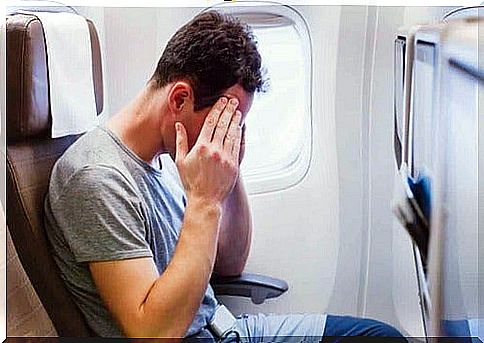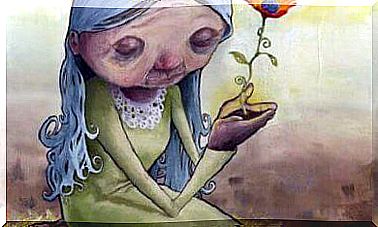Specific Phobias: Indicators To Recognize Them

Specific phobias are associated with an extreme and irrational fear of a particular object or situation. There are countless specific phobias, from the most curious and rare, such as coulrophobia, to the more banal and widespread ones, such as claustrophobia.
Traditionally, specific phobias are divided into four categories: animals, injections, the natural environment and situational. To state the diagnosis of a simple or specific phobia, specialists rely on the diagnostic criteria of the DSM-V or the ICD-10.
Specific phobias are among the most common anxiety disorders. Regarding the impact they have on a person’s life, there are large individual differences: for some people they are very limiting, while for others they are nothing more than a small annoyance.
What are the characteristics of a specific phobia?
One of the difficulties in diagnosing specific phobias concerns the boundary between adaptive fear and phobic fear. In general, specialists agree on the characteristics indicative of a phobic fear reaction:
- It is disproportionate to the characteristics of the situation.
- It cannot be reasonably explained by the sufferer.
- It is beyond our control.
- It pushes to avoid the feared situation.
- It persists over time.
- It is maladaptive.
- It can occur at all ages.
If we take into account the characteristics just mentioned, the most important for differentiating phobic and adaptive fear are persistence, intensity and maladaptive nature compared to adaptive fear.

Age of onset, prevalence and distribution by gender
The prevalence of significant specific phobias ranges from approximately 3% to 12% in the general population. Age of onset can vary greatly. The highest prevalence of specific phobias in children occurs between the ages of 10 and 13.
Specific phobias occur in 2-4% of children. However, only a small number of children need the help of psychotherapy.
On top of that, specific phobias are more common in girls than boys, and symptoms tend to appear earlier in girls than boys.
Clinical features
For specific phobias, help is not sought as often as with other phobias. Therefore, the level of deterioration can be minimal, especially if the chances of confrontation with the phobic object are low.
Most people who seek help to overcome their phobia do so for the following three determining factors:
- There was a change in the patient’s life that made the phobic stimulus acquire greater presence or relevance.
- A sudden event brought out fears that did not exist before and that now condition the patient’s life.
- The person is tired of living with a certain fear and decides to solve the problem by turning to psychotherapy.
The range of stimuli that trigger the fear reaction in an individual with a specific phobia is limited, but the nature of the stimuli is enormous.
Indicators for recognizing some specific phobias
Although studies on the subject suggest an increased risk in first degree relatives, specific phobias can also be acquired at the environmental level through direct and adverse experience with the phobic situation or object.
This experience is believed to excite the amygdala, a key structure involved in the development and coordination of the physiological expression of fear.
Phobia of animals
Animal phobia is the fear of certain animals that are usually not dangerous, such as birds, dogs, cats, etc. It involves fear and avoidance of the animals themselves, not so much disgust or phobia of contact. Fear tends to occur especially when animals are on the move.
As a rule, people fear one type of animal and not other species, and only a minority show fear of the damage the animal could possibly cause.
As curious as it may seem, after the first exposures, in which the person usually uses the avoidance strategy that reinforces fear, tends to fear feeling intense malaise, anticipating a possible exposure, more than the possibility that the animal could attack. .
Blood phobia
The blood and wound phobia exhibit a number of distinctive features. The most important is the biphasic cardiovascular physiological reaction. It can reach a brief asystole, which is accompanied by nausea, sweating, paleness, and sometimes fainting.
Similarly to what happens with animal phobia, anxiety is more related to anticipation of fainting than to phobic stimulus.
Situational phobias
As the name implies, so-called situational phobias manifest themselves in a certain situation. The most representative are the phobias of airplanes, of driving, of crowded places, of heights and of bridges.
The most characteristic aspect of situational phobias is that they can occur both alone and as part of panic disorder with agoraphobia. So much so that some authors have come to think that it is a moderate form of agoraphobia.
Prevalence, epidemiology and course of specific phobias
The prevalence of significant specific phobias ranges from 3% to 12% of the general population. They can occur at any time in our life, but the average age seems to be between 7 and 16, with a range of 3 to 67 years.
Fear of animals and blood occurs first (between ages 7 and 9), followed by fear of heights and claustrophobia. Lastly, driving phobia appears (between 20 and 25 years old).
People with a simple phobia outnumber agoraphobics and social phobics. Nearly half of social phobics and simple phobics are also agoraphobic. Although agoraphobia is a very common anxiety disorder, few seek help.
In specific phobia the degree of disturbance can become tolerable. Specific phobia predominates in women compared to men with a ratio of 1: 1.7. This is confirmed above all in the phobia of animals.

Intervention in the context of specific phobias
The preferred intervention for this type of phobias combines exposure with systematic desensitization. The data collected in several studies tell us that the effects persist for 6 to 12 months after treatment.
In this therapy the patient is exposed to the feared stimulus, but in a progressive and gradual way. This process tries to accustom the person to the stimulus, forcing the decrease of anxiety, which occurs naturally, to occur in the presence of the stimulus.
During this process, the person will come to understand, in higher cognitive processing, that the stimulus is not really a threat. So the goal of the intervention seeks to understand it even at low-level reactive levels.
Since specific phobias often occur in predictable and circumscribed conditions, the use of benzodiazepine for milder cases may be considered clinically appropriate if necessary.
However, studies on benzodiazepines conducted so far have not shown that the results of the intervention are maintained over time.









